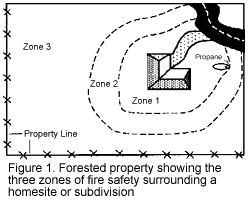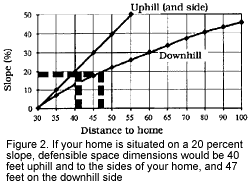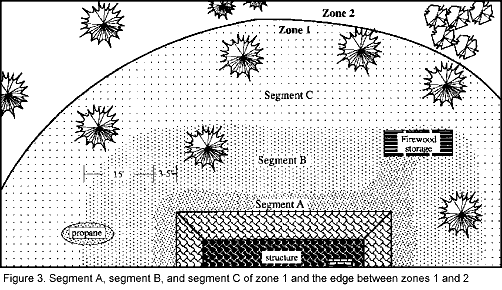Quick
Facts
|
Introduction
One factor has emerged as the primary determinant of a home's ability to survive wildfire. This is the vegetative clearance around the house, or what fire professionals call "Defensible Space." Defensible space is, in simplified terms, "room" for the fire fighters to do their jobs. Your house is more likely to withstand a wildfire if grasses, brush, trees, and other common forest fuels are removed, reduced, or modified to reduce a fire's intensity. These activities will keep fire away from the home and restrict a fire on your property from damaging adjacent lands.
Historically, small areas of modified fuels were thinned around homes within a larger area of dense fuels. This created a "cookie cutter" effect. While moderately helpful, this does not provide adequate protection, particularly in fuels such as lodgepole pine. Recently, this practice was reviewed and improvements of the concept recommended. The expanded system employs a series of zones and segments (Figure 1), described below.
Fire Safety Zones
 Zone 1 is the original (cookie cutter) defensible space
area. It is the area of maximum modification and management
(described in Colorado State Forest Service publications Home
Fire Protection in the Wildland Urban Interface, and Wildfire
Protection in the Wildland Urban Interface).
Zone 1 is the original (cookie cutter) defensible space
area. It is the area of maximum modification and management
(described in Colorado State Forest Service publications Home
Fire Protection in the Wildland Urban Interface, and Wildfire
Protection in the Wildland Urban Interface).
Zone 3 is an area of traditional forest management activities. It is of no specific size, but ideally would extend from the defensible space area to the property boundaries.
Zone 2 is a transitional area between zones 1 and 3. The downhill, uphill and side distance measurements for this area generally are the same as in zone 1, but combined they should extend at least 75 to 100 feet from the house. Within this area, the intent is to "feather" the heavy thinning of zone 1 into the more traditional forest cover of zone 3. This eliminates the wall of dense, unthinned forest fuels which currently exist around defensible space areas, while enhancing homesite safety and the aesthetics of the property.
Prescriptions
Zone
1
 Size of this zone is dependent upon the structure size and the
slope of ground. See Figure 2 for downhill, uphill, and side
distances for specific slopes.
Size of this zone is dependent upon the structure size and the
slope of ground. See Figure 2 for downhill, uphill, and side
distances for specific slopes.
Dispose of all slash in this area by piling and burning, chipping, or hauling away. (Please contact your local Sheriff's office or Colorado State Forest Service [CSFS] district office for more information on burning recommendations.)
Leave no dead (wildlife) trees, except possibly one or two widely-spaced trees at the outer edge of the zone. Be sure such trees cannot fall on the house. An occasional tree may be allowed closer to the house if it is topped to a maximum 10 to 15 feet.
Segment A, the area immediately adjacent to the structure, is 3 to 5 feet wide (Figure 3). Nothing should be planted here, particularly if the house is sided with wood, logs, or other flammable material. Decorative rock or gravel creates an attractive, easily maintained nonflammable ground cover.
Segment B is the area extending from segment A out approximately 15 feet. Allow about 10 feet between tree crowns in this area (Figure 3). Prune trees so that lowest branches are 8 to 10 feet above the ground. Remove all ladder fuels beneath the trees. (Ladder fuels are small shrubs, trees, and tree limbs which could allow a fire to climb into the tree tops.)

Segment C is the outer segment of zone 1, running from the outer edge of segment B to the edge between zone 1 and zone 2. Thin and prune trees and shrubs as described for segment B. Within the outer portions of this zone, small groups of trees and widely-separated individual trees may be left unpruned for landscape purposes.
Zone 2The size of zone 2 is based upon structure size and slope of the ground. These are the same distances as those of zone 1, but the total treated area for zones 1 and 2 combined should extend at least 75 to 100 feet from the house, especially on the downhill side.
Dispose of slash through piling and burning, or chipping. A few small, widely distributed brush piles may be left for wildlife purposes _ no more than 2 or 3 per acre. Small amounts of slash can be lopped and scattered for decomposition. If lop and scatter is used, do not leave continuous areas or large concentrations of slash. (Contact your local office of the Colorado State Forest Service or your local Sheriff's office for information on burning slash piles.)
 Limit the number of dead trees in this zone. Wildlife only
need 2 or 3 per acre. Be sure that these snags cannot fall
onto the house or block access roads or driveways.
Limit the number of dead trees in this zone. Wildlife only
need 2 or 3 per acre. Be sure that these snags cannot fall
onto the house or block access roads or driveways.
Because zone 2 acts as additional protection for the structure, forms an aesthetic buffer, and provides transition between zones, it is necessary to blend the requirements for zones 1 and 3.
Zone 3This zone is of no specified size--it extends from the edge of zone 2 to the property line.
Any approved method of slash treatment is acceptable for this zone, including piling and burning, chipping, or lop-and-scatter.
A greater number of (dead) wildlife trees can remain in this zone, but generally only 2 or 3 per acre are necessary for good wildlife habitat. Make sure that dead trees and snags pose no threat to power lines or fire access roads.
Zone 3 is an area of traditional forest thinning. Typical management objectives for areas surrounding homesites or subdivisions are: to provide optimum recreational opportunities; enhance aesthetics; maintain tree health and vigor; provide barriers for wind, noise, dust, and visual intrusions; support limited production of firewood, fence posts, and other forest commodities; and sustain the growth of Christmas trees or transplants.
Specific thinning requirements are dictated by the landowner's objectives for his land. However, most thinnings are done from below (leaving the biggest and best trees) and on an individual tree selection basis. Thinnings sanitize and improve the forest stand by removing trees that have been damaged, attacked by insects, infected by disease, or are of poor form or low vigor. (For more information about thinning the trees on your property, see the CSFS publication Landowner Guide to Thinning.)
Tree spacing is usually dependent upon the species being managed and factors such as susceptibility to windthrow or damage from heavy snow loading. For ponderosa pine and Douglas-fir, a good rule of thumb for stem spacing is Diameter +7. For lodgepole pine and Engelmann spruce, the stem spacing guide is Diameter + 5. (Diameter is measured in inches and converted to feet. For example, if the average tree to be left after thinning was an 8-inch diameter ponderosa pine, 8 + 7 = 15, for a spacing of 15 feet between trees, as measured between tree stems).
While pruning is generally not necessary in zone 3, it is a good idea from the standpoint of personal safety to prune those trees along trails and fire access roads. Or, if you prefer the aesthetics of a well-manicured forest, there is nothing wrong with pruning the entire area. In any case, any pruning helps reduce "ladder" fuels within the tree stand, thus enhancing fire safety.
Mowing is not necessary in zone 3.
Publication #: 6.302
Cooperative Extension, Colorado State University. Published June 1992. Reviewed October 1992. Copyright 1992. Produced in cooperation with the Colorado state Forest Service. For more information, contact your county Cooperative Extension office or your district State Forest Service office.
Frank C. Dennis, Colorado State Forest Service district forester.
Disclaimer and Reproduction Information: Information in NASD does not represent NIOSH policy. Information included in NASD appears by permission of the author and/or copyright holder. More